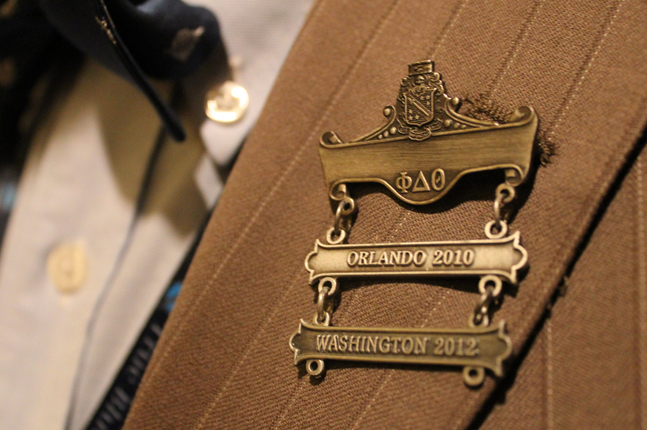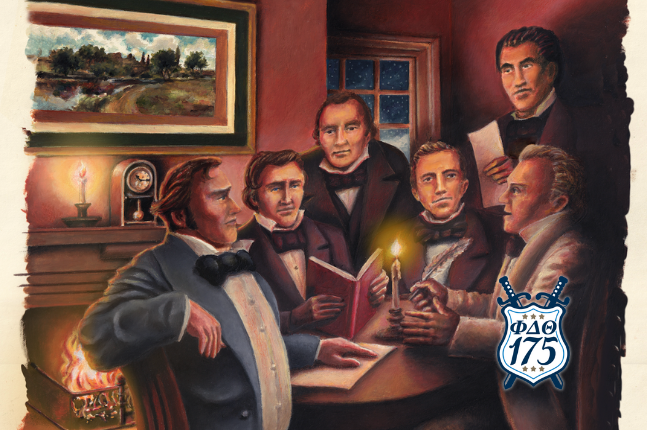By Justin Letcher, Leadership Consultant
Silver metal. Measuring roughly an inch in length and barely an eighth of an inch wide. Words engraved on their faces such as “Estes Park,” “Miami Beach,” and “Oxford,” along with years like “1932,” “1950,” and “2014.” These descriptors are found on the bars collected by brothers at each convention to designate how many they have attended. These silver bars are also known as “rungs” due to the fact that when linked together, they resemble ladders. Thus, the term “convention ladder” came to be. Each rung reads the city and year in which the convention took place.
Research to determine the history of the convention ladder found that this memento of conventions past is decades old. However, research did not determine a specific year of origin or convention that marked the start of this tradition. The earliest pictorial evidence of convention ladders dates back to the 1908 Convention in which a brother in the forefront of the convention photo is wearing a ladder with nine rungs! With the conventions taking place every two years, this dates the first rung back to the 1891 Convention if he attended each convention consecutively.
Earliest known written mentions of the rungs date back to the 1914 Convention. A 1914 edition of The Scroll quotes a letter written by a Massachusetts Alpha Phi reflecting on his convention experience, “so enjoyable was the entire convention that most of the delegates bought convention ‘ladders’, and swore they would have their first reunion, the fates permitting, at the next national convention of [Phi Delta Theta]” (Ira M. Dempsey, Williams ’15). The next mention of the ladders was seen within a 1933 edition of The Scroll written by Illinois Alpha Phi, Frank J.R. Mitchell, “many years ago the practice began of wearing silver bars to indicate the conventions attended and the lengthening ‘ladders’ seen at convention are a striking evidence of the loyalty of old convention-goers. It is hoped that the next convention will witness the lengthening of many ‘ladders’ both long and short.”
Piecing together a history of this proud tradition was difficult due to the fact that the General Headquarters did not officially produce and purchase these bars initially. Individuals themselves, it would seem, purchased them through an outside vendor. Additionally, some of the brothers pictured in photos with rungs are members of the Chapter Grand and not available for comment on how they went about obtaining their ladders.
Robert J. Miller (New Mexico ’50), Executive Vice President Emeritus and current Fraternity Historian, owns the longest convention ladder at 34 rungs. It will soon increase to 35 with this year’s convention in Savannah. His first bar is from the 1948 Oxford Convention. According a 1954 volume of The Scroll, “the previous record was held by the late ‘Polly’ Ruick [P.P.G.C.*] who had 26 rungs on his convention ladder at the 1950 Chicago Convention – his last.” Even before Brother Ruick, the longest had been owned by George Banta Sr., whose ladder was 19 rungs long. Brother Banta had first attended convention in 1878 and his last was in 1930. With 52 years between his first and last conventions, that means he attended 26 conventions, which raises the question of why he only had 19 rungs? When did the rungs start? These questions still remain along with others. We might never know the full history behind this convention tradition. What we can say for certain though is well said by Past President of the General Council Scott Mietchen, “as Phis attend more conventions, the ladders lengthen, and provide striking evidence of a Phi’s devotion to the Fraternity.”
Phi Delta Theta’s 81st Biennial Convention is quickly approaching, and more than 600 Phis will flood into the historic streets of Savannah, Georgia. Convention has been lauded as not only a time for legislative action in an effort to adapt to changing times, but also an opportunity to celebrate together our great Fraternity and our Bond as brothers in an unique environment. Whether this will be your first convention, or your 31st, consider getting yourself that silver bar with the word “Savannah” and numbers “2016” engraved on its face. It will act as a memento of one of the greatest Phi Delt experiences you may ever have.
Addendum:
In the article posted on June 9th of this year, I stated that the earliest pictorial evidence of the convention ladders in use was from the year 1908. A recent development has occurred to provide us a bit more insight into the history of this convention tradition. In the General Headquarters building there are a number of vaults. In one of these vaults, by pure happenstance, CEO Bob Biggs wandered upon an “artifact”, if you will, while searching for a completely unrelated item. What he found was the oldest Convention Ladder known to our organization. The ladder was owned by the now deceased Samuel “Polly” Ruick, President of General Council (1908-1910), who was mentioned in the initial piece for his appearance in a picture featuring him and his 26-rung ladder. That picture was from his last convention in 1950. The first bar on his rung? Philadelphia – 1896.
Like before, questions remain and we may never know all the answers. For example, were the ladders and rungs made as early as 1896? Or were they made later and delegates retroactively added rungs for past conventions they had attended? The answers likely have been laid to rest with brothers in the Chapter Grand. What does remain true is that another rung was earned by hundreds of Phis in Savannah in June 2016 and as the ladders for many Phi brothers continue to grow longer, so does this time honored tradition.
*Stands for Past President of the General Council.





